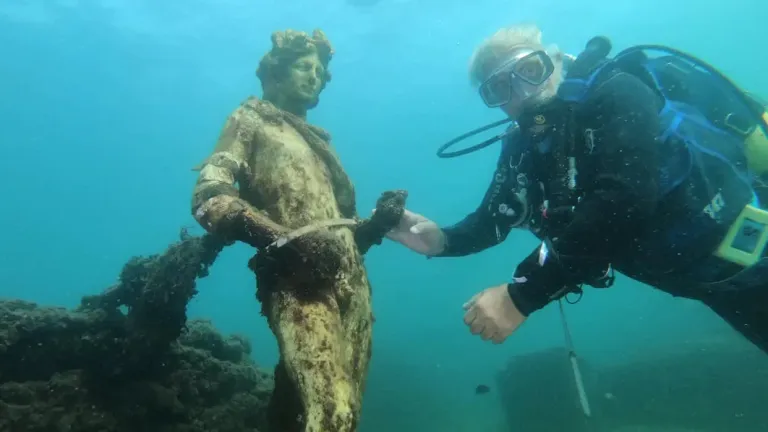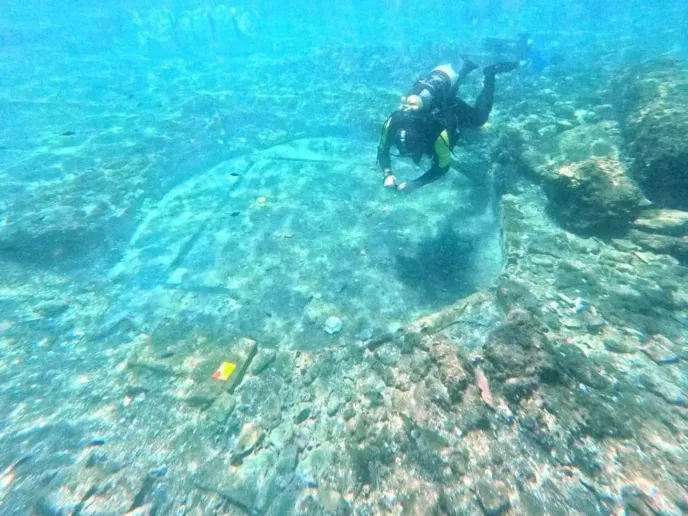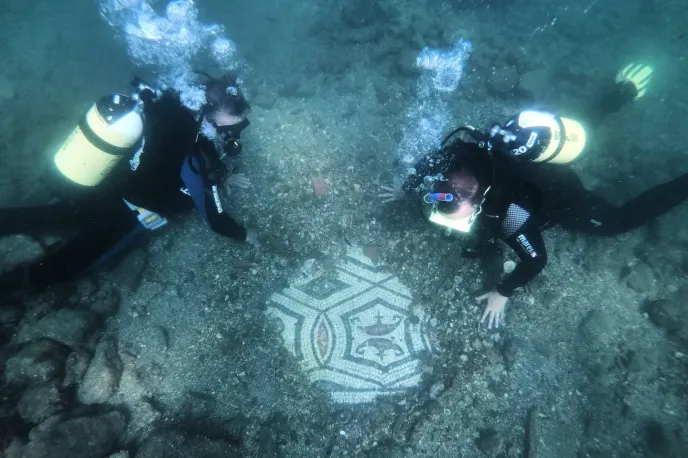Lost Ancient Roman Spa Discovered Underwater: Cicero’s Hidden Luxury Retreat Resurfaces

Imagine a perfectly preserved Roman spa, submerged three meters below the Mediterranean’s waves, complete with heated floors, intricate mosaics, and what could be the personal bathhouse of one of the greatest orators in history. This fantasy has become reality off the coast of Naples, Italy, where marine archaeologists have uncovered a treasure trove that may be the most significant underwater archaeological discovery to date.
This remarkable find has captured the imagination of history enthusiasts and archaeologists alike, but it’s more than just an ordinary bathhouse. Experts believe it could be the lost villa of Marcus Tullius Cicero, the famed Roman politician and philosopher whose influence still resonates in the world of law and philosophy.
Baiae: The Luxury Playground of Ancient Rome
To grasp the full significance of this discovery, one must understand the extravagant world of Baiae. Think of the most exclusive resort destination you can imagine, then amplify that with the power and wealth of the Roman Empire. Baiae, during its peak, was the epitome of luxury and excess, a coastal paradise where Rome’s elite would unwind, indulge in hot springs, and engage in activities that might rival modern-day Las Vegas.

Recreational divers explore the ruins of domed bathhouses built for emperors at Baiae at the Campi Flegrei Archaeological Park. Andreas Solaro/AFP via Getty Images
This was no ordinary Roman town. Baiae earned the reputation of a “harbor of vice,” with contemporary writers documenting the hedonistic lifestyle enjoyed by its visitors. The poet Sextus Propertius referred to it as a “vortex of luxury,” and the names of those who frequented the town were a who’s who of Roman power and opulence—Julius Caesar, Augustus, Nero, and military leaders like Pompey the Great.
A Town Submerged by Time
However, Baiae’s very appeal led to its demise. Located on the volcanic Phlegraean Fields near Naples, the town thrived due to its natural hot springs, believed to have miraculous healing properties. But, living near an active volcanic system came with its own set of risks, ones that Roman engineering could not prevent.
By the 16th and 18th centuries, volcanic activity and seismic shifts slowly pushed much of Baiae beneath the waves. The grand villas with panoramic views of the Bay of Naples became submerged, leaving an underwater ghost town that preserved the city’s architecture and artwork in an aquatic time capsule. By 1500 CE, a combination of volcanic subsidence and malaria outbreaks caused the once-glorious resort to be abandoned.
A Remarkable Discovery Beneath the Waves
Fast forward to 2023, when underwater archaeologists, conducting routine surveys in Zone B of what is now the Baia Underwater Park, discovered something extraordinary. Three meters below the surface, they found the outline of an extraordinarily well-preserved Roman bathhouse. While it was clear they had stumbled upon something special, the full extent of the find only became apparent later.
What they uncovered was a stunning example of Roman engineering. The centerpiece of the bath complex is a laconicum, an ancient sauna, highlighting the advanced technology Romans used for luxury living. The mosaic floor, still intact and supported by the original system of pilae (pillars), remains in exceptional condition, offering a glimpse into the beauty and sophistication of ancient Roman spas.
The heating system, featuring hollow tiles (called tubuli) in the walls, allowed for evenly distributed heat—an ancient marvel that would make modern spa designers envious. It’s a testament to the Romans’ commitment to comfort, with a level of climate control that wouldn’t be seen again in Europe for centuries.
Artistic Glimpses into Roman Luxury
What makes this find even more remarkable is the artistic treasures that lie beneath the waves. Traces of ancient wall paintings still cling to the bathhouse walls, offering a rare and tantalizing glimpse into the artistic tastes of Rome’s elite. Although the frescoes are fragmentary, they provide valuable insight into the opulent designs that adorned the interiors of luxury Roman leisure spaces.
The mosaic floor, in particular, is a rare example of Roman craftsmanship. Unlike many mosaics that have been damaged by time or human interference, this one has been preserved by its underwater environment. Marine archaeologists have described the condition of the mosaic as exceptional, with intricate patterns and colors still visible through the crystal-clear Mediterranean waters.

Recreational divers explore the ruins of domed bathhouses built for emperors at Baiae at the Campi Flegrei Archaeological Park. Andreas Solaro/AFP via Getty Images
Fragments of pottery and ceramics are also being analyzed, and experts hope that these relics will shed light on the dating of the complex and offer more clues about how it met its watery end.
The Cicero Connection
Now, here’s where the story gets truly exciting. Historical records suggest that this bath complex may have once been part of Cicero’s villa, and if confirmed, it would be the first physical evidence of the famous orator’s private retreat.
Cicero, not just a Roman politician but arguably the greatest public speaker in Roman history, was known for his philosophical writings and his involvement in the political intrigues of his time. His letters and speeches offer unique insights into Roman life during the late Republic, and he was undoubtedly drawn to Baiae’s luxury and strategic location. The resort offered a perfect blend of relaxation and networking, where political deals could be forged in between luxurious bathhouse sessions and lavish dinner parties.
If this site is indeed Cicero’s villa, it would provide a tangible connection to one of history’s most influential thinkers, showing where he may have retreated to write, think, and craft the speeches that would shape the future of the Western world.
The Rediscovery of Baiae
The journey to rediscover Baiae began in the 1920s when intact marble sculptures were found during dredging operations. The significance of this find was so great that Benito Mussolini even considered draining the entire area to uncover the rest of the ancient city, though thankfully, that idea never came to fruition.
In the 1940s, an Italian air force pilot flew over the area and noticed what he described as a “strange ghost town” beneath the sea. His aerial photographs helped map the underwater ruins, sparking renewed archaeological interest.
Today, the submerged ruins of Baiae have become a popular tourist destination. Certified divers can explore the ancient streets where Roman senators once walked and swim through the villa courtyards where emperors held court. For those who prefer to stay dry, glass-bottomed boats offer visitors the chance to view the ruins and see the intricate mosaics and architecture with startling clarity.
Roman Engineering Marvels
What continues to astonish researchers is the sophistication of Roman engineering at Baiae. The heating system in the bathhouse, known as the suspensurae, is a prime example. This system used hot air from a furnace, which was then channeled through pillars beneath the floor and hollow tiles in the walls to provide even, comfortable heating. This innovative climate control system was advanced for its time and would not be matched again in Europe for centuries.
Moreover, the bathhouse’s layout, with rooms of varying temperatures, allowed bathers to experience a progression from warm to hot to cool, mimicking the spa experience modern designers strive to replicate today.
The Future of Baiae’s Secrets
Underwater archaeology presents unique challenges, including the need for specialized diving gear and working in an environment shared by curious marine life. However, the underwater setting has helped preserve the ruins, protecting them from the wear and tear that land-based sites face. The lack of oxygen at the seafloor has prevented the usual decay of organic materials, while the consistent temperature has kept delicate artistic elements intact.
Despite these challenges, archaeologists are making remarkable strides in preserving the site. Conservation efforts will continue as they clean the mosaic floor and protect the surviving wall paintings. Analysis of the pottery fragments will provide more definitive evidence about the timeline of the bathhouse’s construction and eventual submersion.
A Glimpse into Ancient Lives
The discovery of Cicero’s possible villa isn’t just a historical find—it’s a chance to understand the real lives of the people who shaped history. Ancient Roman figures weren’t just distant characters from textbooks; they were real people who, like us, sought luxury, relaxation, and connection with others. The rediscovery of their bathhouses, villas, and artworks brings their world closer to ours, allowing us to step into their shoes—even if only for a moment.
As more is uncovered at Baiae, we’ll gain deeper insights into Roman life, art, and culture. And if the connection to Cicero is confirmed, this site could rewrite our understanding of the great orator’s personal life and political strategies.
For now, the waters of the Gulf of Naples continue to protect the secrets of Baiae. But with each dive and every discovery, archaeologists are bringing the lost world of ancient Rome back to the surface. And who knows what else lies beneath, waiting to be uncovered from the depths of time.




